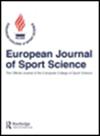超重对下肢垂直刚度和步行代谢成本的影响
IF 3
3区 医学
Q2 SPORT SCIENCES
引用次数: 2
摘要
目的是检验下肢垂直刚度和步态力学是否能解释正常体重(NW)和肥胖(OB)个体行走能量消耗(Cw)的差异。10名OB(33.1±2.0 kg m - 2)和10名NW(24.2±1.3 kg m - 2)在仪器化跑步机上以1.25 m s - 1的速度行走6分钟,同时测量Cw、下肢运动学和垂直刚度(K vert)。NW用负重背心(NWL)完成了另一项试验,以模拟肥胖组的BMI。OB组Cw值(277.5±45.3 J m−1)比NW组(211.0±27.0 J m−1)高24%,NWL组Cw值(272.7±35.7 J m−1)比NW组(211.0±27.0 J m−1)高23%,P < 0.05。不同条件下的质量特异性K vert (P = 0.081)相似。K vert与Cw相关(r = 0.55, P = 0.001)。体重与体重差异无统计学意义,但体重指数与体重呈负相关,主要原因是体重较低。Cw和K vert与体重成比例共变,但质量特异性K vert与Cwkg无关。由于NWL的攻角、质心位移和关节活动范围更大,NWL的质量比K vert比OB低。本文章由计算机程序翻译,如有差异,请以英文原文为准。
Influence of excess weight on lower-extremity vertical stiffness and metabolic cost of walking
ABSTRACT The purpose was to test whether lower-extremity vertical stiffness and gait mechanics explain differences in energy cost of walking (Cw) between individuals with normal weight (NW) and obesity (OB). Ten OB (33.1 ± 2.0 kg m−2) and 10 NW (24.2 ± 1.3 kg m−2) walked for six minutes on an instrumented treadmill at 1.25 m s−1 while Cw, lower-extremity kinematics, and vertical stiffness (K vert) were measured. NW completed another trial with a loaded vest (NWL) to simulate the BMI of the obese group. Cw was 24% greater in OB (277.5 ± 45.3 J m−1) and 23% greater in NWL (272.7 ± 35.7 J m−1) than NW (211.0 ± 27.0 J m−1, P < 0.005). Mass-specific Cw (Cwkg) wasn’t different between conditions (P = 0.085). Lower-extremity K vert was 40% higher in OB (32.7 ± 5.2 kN m−1) than NW (23.3 ± 4.7 kN m−1, P < 0.001), but neither was different from NWL (27.5 ± 3.4 kN m−1, P > 0.05). Mass-specific K vert (P = 0.081) was similar across conditions. K vert was related to Cw (r = 0.55, P = 0.001). Cwkg wasn’t different between NW or OB, but there was a negative correlation between BMI and Cwkg driven by lower Cwkg in NWL. Cw and K vert covaried in proportion to body mass, but mass-specific K vert was unrelated to Cwkg. Mass-specific K vert was lower in NWL than OB due to NWL’s greater angle of attack, center of mass displacement, and joint range of motion.
求助全文
通过发布文献求助,成功后即可免费获取论文全文。
去求助
来源期刊
CiteScore
6.60
自引率
3.10%
发文量
153
审稿时长
6-12 weeks
期刊介绍:
The European Journal of Sport Science (EJSS) is the official Medline- and Thomson Reuters-listed journal of the European College of Sport Science. The editorial policy of the Journal pursues the multi-disciplinary aims of the College: to promote the highest standards of scientific study and scholarship in respect of the following fields: (a) Applied Sport Sciences; (b) Biomechanics and Motor Control; c) Physiology and Nutrition; (d) Psychology, Social Sciences and Humanities and (e) Sports and Exercise Medicine and Health.

 求助内容:
求助内容: 应助结果提醒方式:
应助结果提醒方式:


